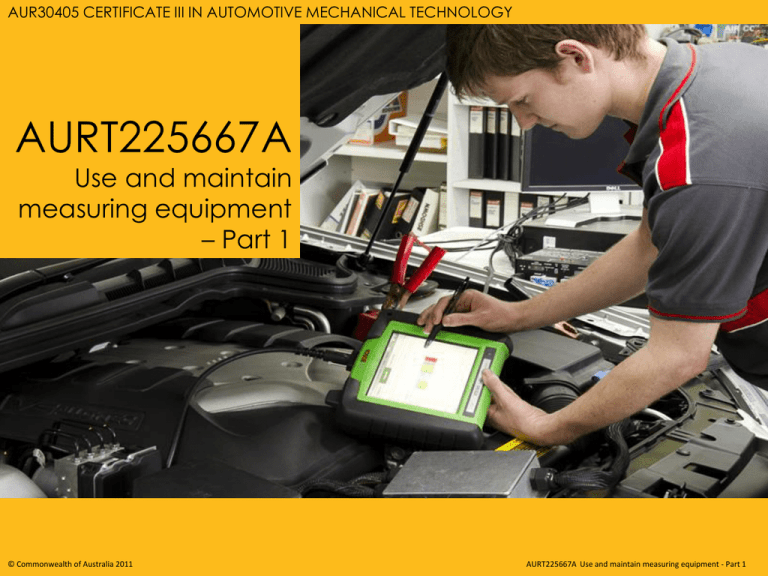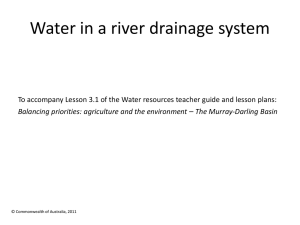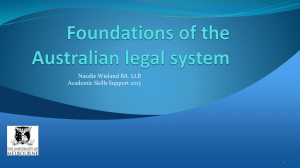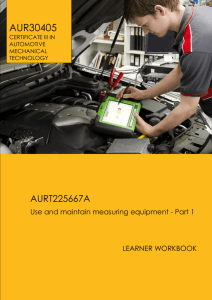
AURT225667A
AUR30405
CERTIFICATE
USE ANDIIIMAINTAIN
IN AUTOMOTIVE
MEASURING
MECHANICAL
EQUIPMENT
TECHNOLOGY
– PART 1
1
AURT225667A
Use and maintain
measuring equipment
– Part 1
© Commonwealth of Australia 2011
AURT225667A Use and maintain measuring equipment - Part 1
AURT225667A USE AND MAINTAIN MEASURING EQUIPMENT – PART 1
2 1
Introduction to measuring
Measuring must be done accurately.
Measure size, fit,
clearance, pressure,
temperature or
other specification.
Measure and adjust –
• spark plug gaps
• valve clearances
• fuel pressures
• what else?
© Commonwealth of Australia 2011
AURT225667A Use and maintain measuring equipment - Part 1
AURT225667A USE AND MAINTAIN MEASURING EQUIPMENT – PART 1
3 2
Measuring accurately
Measuring tools can easily be
damaged. Damaged tools are
inaccurate.
• Don’t drop or mis-handle them.
• Check them regularly for accuracy.
To measure accurately:
• Handle measuring tools
correctly
• Select measuring tools that are
accurate for the work
• Check measuring tool is
reading accurately.
© Commonwealth of Australia 2011
AURT225667A Use and maintain measuring equipment - Part 1
AURT225667A USE AND MAINTAIN MEASURING EQUIPMENT – PART 1
4 3
Measuring equipment
feeler gauge
steel rule
straight edge
outside calliper
micrometer
vernier calliper
© Commonwealth of Australia 2011
dial indicator
AURT225667A Use and maintain measuring equipment - Part 1
AURT225667A USE AND MAINTAIN MEASURING EQUIPMENT – PART 1
5
Manual lifting safety
Measuring sometimes involves working with
heavy or awkward machinery or parts eg
cylinder heads, cylinder blocks and crankshafts.
• Use stands, chocks, or “V” blocks to stop
parts moving.
• When lifting or moving heavy parts - ask for
help, or use a crane or lifting equipment.
© Commonwealth of Australia 2011
AURT225667A Use and maintain measuring equipment - Part 1
AURT225667A USE AND MAINTAIN MEASURING EQUIPMENT – PART 1
6
Flat Feeler Gauge
• Hardened steel blades of different
thicknesses
• Each blade marked with its size in
millimeters and/or inches.
Useful for:
• measuring small slots or grooves
• measuring clearances of machinery,
eg valve or tappet clearance.
© Commonwealth of Australia 2011
AURT225667A Use and maintain measuring equipment - Part 1
AURT225667A USE AND MAINTAIN MEASURING EQUIPMENT – PART 1
7
Wire feeler gauge
• Has several wires, each with a different thickness
• Designed to check and adjust spark plug gaps
• Has a gap adjuster, to bend the earth electrode on the
spark plug.
© Commonwealth of Australia 2011
AURT225667A Use and maintain measuring equipment - Part 1
AURT225667A USE AND MAINTAIN MEASURING EQUIPMENT – PART 1
8
Straight edge
• Made from a thick wide strip of alloy
steel
• Hardened and ground to form two
parallel flat edges
• Usually between 150mm to l000mm
in length.
• Can be used for checking the flatness
of a surface.
• Used to measure the gap between
the straight edge and a surface eg on
a cylinder head.
© Commonwealth of Australia 2011
AURT225667A Use and maintain measuring equipment - Part 1
AURT225667A USE AND MAINTAIN MEASURING EQUIPMENT – PART 1
9
Steel rules
• Used for general measurements
• Graduated in millimeters and
centimeters.
Care
• Handle carefully.
• The zero end of the rule must be
• Kept in perfect condition to maintain
accuracy.
© Commonwealth of Australia 2011
AURT225667A Use and maintain measuring equipment - Part 1
AURT225667A USE AND MAINTAIN MEASURING EQUIPMENT – PART 1
10
Measuring with a steel rule
• Generally measure to
an accuracy of 1 mm.
• Some measure to an
accuracy of 0.5mm.
To measure length:
• Place the end of the ruler flush with start of material.
• Look at exact place on rule where material ends.
• Read length on ruler scale.
© Commonwealth of Australia 2011
AURT225667A Use and maintain measuring equipment - Part 1
AURT225667A USE AND MAINTAIN MEASURING EQUIPMENT – PART 1
11
Caring for callipers
Callipers are precision instruments. Protect from damage:
• Keep in own protective cases
• Never keep loose in a toolbox with other tools
• Never drop or knock sharply
• Never use excessive force when measuring
• Clean metal parts with a slightly oily rag
• Clean plastic parts with a dry rag
• Inspect jaws for damage
• Replace batteries regularly in digital callipers.
© Commonwealth of Australia 2011
AURT225667A Use and maintain measuring equipment - Part 1
AURT225667A USE AND MAINTAIN MEASURING EQUIPMENT – PART 1
12
Sliding jaw callipers
• Have own measuring scales built in
• Very accurate - some can measure to 0.01mm (1/100 of a millimetre)
Dial-type callipers
Digital callipers
Vernier callipers
© Commonwealth of Australia 2011
AURT225667A Use and maintain measuring equipment - Part 1
AURT225667A USE AND MAINTAIN MEASURING EQUIPMENT – PART 1
13
Using sliding jaw callipers
Depth gauge measure steps/
heights/ depth of holes.
External jaws measure
outside diameters/
thickness/ length.
Internal jaws measure
gaps/ internal diameters.
© Commonwealth of Australia 2011
AURT225667A Use and maintain measuring equipment - Part 1
AURT225667A USE AND MAINTAIN MEASURING EQUIPMENT – PART 1
14
Using dial-type callipers
1. Clean jaws and close completely.
2. Check dial = 0. Adjust if necessary by rotating & locking dial.
3. Gently close jaws on part being measured. When “feel” is
correct, lock slide.
4. Read number of whole millimetres on left of reference face.
5. Note dial reading, and add it to whole mm reading.
© Commonwealth of Australia 2011
AURT225667A Use and maintain measuring equipment - Part 1
AURT225667A USE AND MAINTAIN MEASURING EQUIPMENT – PART 1
15
Using digital callipers
• Can make measurements as small as 0.001mm (1/1000 millimetre)
• Measurements shown directly on digital display
• Display can switch between metric and imperial measurements.
1. Clean & close jaws
2. Press ON button
3. Press ZERO button
4. Check display reads
zero, then make
measurement.
© Commonwealth of Australia 2011
AURT225667A Use and maintain measuring equipment - Part 1
AURT225667A USE AND MAINTAIN MEASURING EQUIPMENT – PART 1
16
The vernier calliper
• Has a special vernier scale marked on the sliding jaw
• Measures down to 0.02mm (2/100 millimetre)
Inside jaws
Locking screw
Main scale
Depth gauge
vernier scale
Sliding jaws
Outside jaws
© Commonwealth of Australia 2011
AURT225667A Use and maintain measuring equipment - Part 1
AURT225667A USE AND MAINTAIN MEASURING EQUIPMENT – PART 1
17
Using the vernier calliper
1. Before measuring, close jaws and
check that main scale zero mark
lines up exactly with vernier scale
zero mark.
2. Adjust jaws.
3. You may need to gently “rock” the
jaws to get the right feel – not too
tight, not too loose.
4. Lock the slide.
© Commonwealth of Australia 2011
AURT225667A Use and maintain measuring equipment - Part 1
AURT225667A USE AND MAINTAIN MEASURING EQUIPMENT – PART 1
18
Using the vernier calliper cont’d
5. Read number of whole
millimetres on main scale,
before the vernier zero
6. Look for a vernier scale
graduation which lines up
exactly with any graduation
on the main scale
16 whole mm
0.38 mm
7. Read fraction number on
vernier scale where the
marks line up
8. Add fraction to whole
millimetres to get final
measurement.
© Commonwealth of Australia 2011
Example: 16.00 whole mm
+ 0.38 mm on vernier
= 16.38 mm
AURT225667A Use and maintain measuring equipment - Part 1
AURT225667A USE AND MAINTAIN MEASURING EQUIPMENT – PART 1
19
Micrometers
• Use to take very accurate measurements
• 3 types - may look different but all use the same
principle.
1. Outside micrometer
2. Inside micrometer
3. Depth micrometer
1. The outside micrometer
• Measures width and length
• Used for precise measurements eg
reconditioning an engine,
measuring pistons, valves,
crankshafts etc.
© Commonwealth of Australia 2011
AURT225667A Use and maintain measuring equipment - Part 1
AURT225667A USE AND MAINTAIN MEASURING EQUIPMENT – PART 1
20
Micrometers
2. Inside micrometer
• measures the inside of holes or
bores.
© Commonwealth of Australia 2011
3. Depth micrometer
• measures the depth of holes/
grooves/ recesses and the height
of shoulders.
AURT225667A Use and maintain measuring equipment - Part 1
AURT225667A USE AND MAINTAIN MEASURING EQUIPMENT – PART 1
21
Caring for micrometers
Precision instruments must be treated
carefully.
Always:
• Clean face of spindle and anvil.
• Check zero reading before use.
• Avoid dirty or rough components.
• Do not adjust micrometers unless
trained to do so.
• After use - clean, lightly oil, and
store in a protective box.
© Commonwealth of Australia 2011
AURT225667A Use and maintain measuring equipment - Part 1
AURT225667A USE AND MAINTAIN MEASURING EQUIPMENT – PART 1
22
The outside micrometer
Measuring range =
The minimum and maximum distance it can measure. It is marked on the
frame.
This micrometer can measure:
• between 0 - 25 millimeters (25mm)
• to an accuracy 1/100 of a
millimeter (0.01mm ).
© Commonwealth of Australia 2011
AURT225667A Use and maintain measuring equipment - Part 1
AURT225667A USE AND MAINTAIN MEASURING EQUIPMENT – PART 1
23
Outside micrometer cont.
Can accurately measure the distance
between two machined surfaces eg.
- thickness of a shim washer
- diameter of a crankshaft journal.
This micrometers has a range
of 50 – 75mm.
Micrometers should have no zero error.
They are tested with a special, very
accurate test piece.
© Commonwealth of Australia 2011
AURT225667A Use and maintain measuring equipment - Part 1
AURT225667A USE AND MAINTAIN MEASURING EQUIPMENT – PART 1
24
More micrometers
Vernier micrometer
• has an extra vernier scale on the
sleeve
• can measure down to 0.001mm
(1/1000 of a millimetre).
Digital micrometer
• has a display which shows the
measurement
• may have a conventional scale as well.
© Commonwealth of Australia 2011
AURT225667A Use and maintain measuring equipment - Part 1
AURT225667A USE AND MAINTAIN MEASURING EQUIPMENT – PART 1
25
Using the outside micrometer
Hold micrometer by frame
with your left hand.
Open micrometer and clean
anvils with a clean cloth.
Check accuracy
Gently close micrometer with
ratchet until anvils are touching
or use a test piece.
Look at the scales - they should
both read zero.
© Commonwealth of Australia 2011
AURT225667A Use and maintain measuring equipment - Part 1
AURT225667A USE AND MAINTAIN MEASURING EQUIPMENT – PART 1
26
Reading the micrometer scale
The sleeve is marked with numbered
graduations = whole millimetres.
Sleeve also has half millimetre
graduations marked.
© Commonwealth of Australia 2011
Around the thimble - 50
graduations, beginning and ending
at 0.
AURT225667A Use and maintain measuring equipment - Part 1
AURT225667A USE AND MAINTAIN MEASURING EQUIPMENT – PART 1
27
Reading the micrometer scale
One full turn of the thimble opens
the micrometer by exactly 0.50mm.
A “half mm” graduation is just
visible on the datum line.
Two full turns opens the anvils
by exactly 1.00 mm.
The 1 mm graduation is just
showing on the datum line.
© Commonwealth of Australia 2011
AURT225667A Use and maintain measuring equipment - Part 1
AURT225667A USE AND MAINTAIN MEASURING EQUIPMENT – PART 1
28
Reading the micrometer scale
Remember – 1 thimble division = 0.01 mm.
To get the final measurement:
1. Note the number of whole
millimetres visible on the datum line.
0.01mm
2. Add any half millimetres showing on
the datum line.
3. Add the number of thimble
graduations lined up with the datum
line.
© Commonwealth of Australia 2011
AURT225667A Use and maintain measuring equipment - Part 1
AURT225667A USE AND MAINTAIN MEASURING EQUIPMENT – PART 1
29
Reading the Micrometer Scale
Example 1
4 whole mm showing
= 4.00 mm
1 half mm showing
= 0.50 mm
5 indicated on the thimble= 0.05 mm
TOTAL = 4.55 mm
Example 2
5 whole mm showing
= 5.00 mm
1 half mm showing
= 0.50 mm
12 indicated on the thimble = 0.12 mm
TOTAL = 5.62 mm
© Commonwealth of Australia 2011
AURT225667A Use and maintain measuring equipment - Part 1
AURT225667A USE AND MAINTAIN MEASURING EQUIPMENT – PART 1
30
Dial indicator gauge
Also called a dial gauge or dial indicator.
• Has a face or dial marked in divisions of 0.01 mm (1/100 mm)
• Does not take a direct measurement - shows variations from the original
zero setting
• These variations are transferred from the spindle to the pointer.
© Commonwealth of Australia 2011
AURT225667A Use and maintain measuring equipment - Part 1
AURT225667A USE AND MAINTAIN MEASURING EQUIPMENT – PART 1
31
Dial indicator
• Used to measure:
- the bend or run-out in a shaft
- the clearance between two
parts eg between an engine
valve and its guide.
• Must be firmly mounted. A magnetic
stand or a stand with a screw clamp
is often used.
© Commonwealth of Australia 2011
AURT225667A Use and maintain measuring equipment - Part 1
AURT225667A USE AND MAINTAIN MEASURING EQUIPMENT – PART 1
32
Setting up the dial indicator
1. Mount dial gauge firmly on its
stand
2. Mount stand securely, to
prevent damage from dropping
or excessive vibration
3. Keep spindle at right angles
(perpendicular) to the surface
being checked.
© Commonwealth of Australia 2011
AURT225667A Use and maintain measuring equipment - Part 1
AURT225667A USE AND MAINTAIN MEASURING EQUIPMENT – PART 1
33
Reading the dial indicator
1. Read the whole millimetres
from the inner scale (only for
absolute measurements)
2. Read the tenths of
millimetres (numbers on
outer scale)
3. Read the hundredths of
millimetres (small divisions on
outer scale).
© Commonwealth of Australia 2011
AURT225667A Use and maintain measuring equipment - Part 1
AURT225667A USE AND MAINTAIN MEASURING EQUIPMENT – PART 1
34
Reading the dial indicator
Example
Step 1
Step 1
Step 3
Read the whole millimetres. The short
needle is between the 4 and the 5, so
the reading is 4.00 mm.
Step 2
Read the tenths. The long needle is
between the 0.20 and the 0.30 mm, so
the reading is 0.20 mm.
Step 3
Step 2
The long needle is 6 small divisions
past the 2, so the reading is 0.06 mm.
© Commonwealth of Australia 2011
AURT225667A Use and maintain measuring equipment - Part 1
AURT225667A USE AND MAINTAIN MEASURING EQUIPMENT – PART 1
35
Reading the dial indicator
Step 4
To get the final measurement
- add up the measurements
from Steps 1, 2, & 3.
Step 1
4.00 mm
Step 2
+ 0.20 mm
Step 3
+ 0.06 mm
4.00 mm
0.20 mm
0.06 mm
Total = 4.26 mm
© Commonwealth of Australia 2011
AURT225667A Use and maintain measuring equipment - Part 1
AURT225667A USE AND MAINTAIN MEASURING EQUIPMENT – PART 1
36
© Commonwealth of Australia 2011
ISBN: 978-1-876838-44-7
This document is available under a “Free for Education” licence for educational purposes – see http://www.aesharenet.com.au/FfE2 for details.
This work is copyright. You may download, display, print and reproduce this material in whole or in part or in modified form (retaining this notice) for your
personal, non-commercial use or use within your organisation. If you use, display, or reproduce this material or a modified form of it in whole or in part within
your organisation you must include the following words in a prominent location within the material in font not less than size 12: ‘The views expressed in this
publication do not necessarily represent the view of the Minister for Education or the Australian Government. The Australian Government does not give any
warranty nor accept any liability in relation to the contents of this work’. Apart from any use as permitted under the Copyright Act 1968, all other rights are
reserved. Requests and inquiries concerning reproduction and rights should be addressed to the Commonwealth Copyright Administration, Attorney General’s
Department, Robert Garran Offices, National Circuit, Barton ACT 2600 or posted at http://www.ag.gov.au/cca.
Funded under the Workplace English Language and Literacy (WELL) Program by the Australian Government Department of Education, Employment and
Workplace Relations.
The views expressed in this publication do not necessarily represent the view of the Minister for Education or the Australian Government. The Australian
Government does not give any warranty nor accept any liability in relation to the contents of this work.
© Commonwealth of Australia 2011
AURT225667A Use and maintain measuring equipment - Part 1









